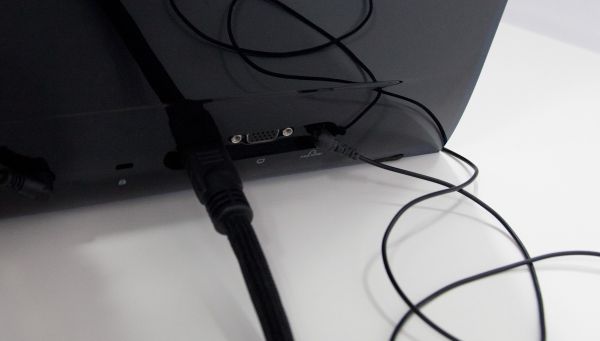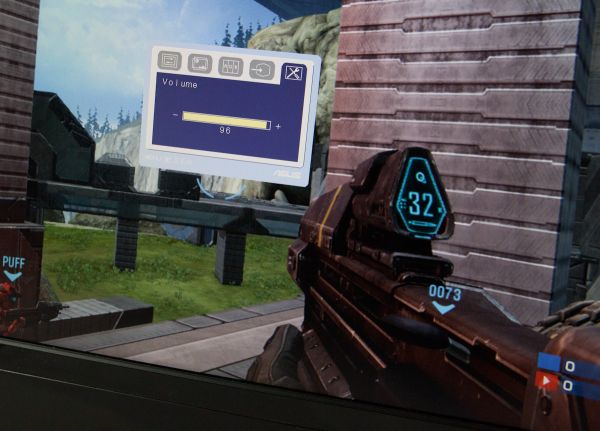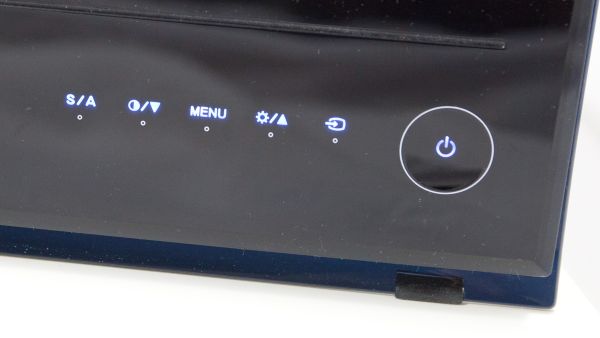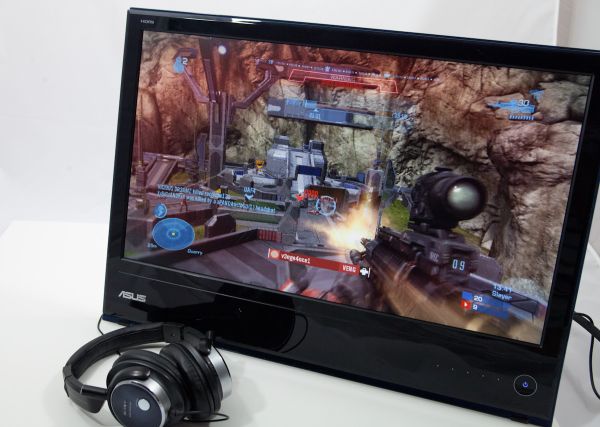ASUS MS238H Review - Slim and Affordable
by Brian Klug on December 24, 2010 1:47 AM ESTOSD and Gaming
One of the nice things about the MS238H is that the display includes a much-needed 3.5mm headphone jack for HDMI audio pass through. It's amazing how many displays include HDMI, yet provide no audio out options for when you want to connect a game console and just use HDMI. On displays without the jack, the only alternative is using old-school RCA plugs and a 3.5mm headphone jack converter, and (because I've yet to find one that has a female plug) probably a female-female headphone jack so you can actually use the connection. More and more displays are starting to carry an option for stereo out like the MS238H does, however, which is awesome.
Even better, the OSD controls include volume controls, which is incredibly welcome even if it takes at least 5 OSD selections to actually reach the volume control window. The only problem with the headphone jack on the MS238H is its location - it's on the rear which is a bit of an inconvenience if you're constantly swapping headsets or don't have a long cable. On the other hand, since there's only one HDMI jack, if you're switching from your desktop to a console constantly, you're going to have to go back there anyways.
I normally leave our OSD walkthrough until the end, but I think it's worth mentioning that the OSD controls include the right set of scaling options: full, 4:3, and overscan. There's no 1:1 explicitly provided, but if you're using HDMI chances are good you're connecting to something which drives the panel's native resolution of 1920x1080 so it's a moot point. The OSD style and majority of settings are essentially the same as I saw on the VG236H.
I can't complain about the OSD on the MS238H - it's standard ASUS fare with the appropriate changes for this particular panel. There are presets which include standard and game modes, overdrive controls under "Trace Free" (which basically gets turned on when you select game mode), dynamic contrast under "ASCR", RGB gain controls, aspect ratio, volume, and more. All in all nothing surprising or out of the ordinary.
I did find that sometimes the capacitive OSD buttons can mis-sense a press and keep sending input for a few seconds after your finger is lifted off the button. While adjusting brightness and contrast for calibration, I unintentionally sent the display to maximum and minimum a few times more than I would've liked to. After a few presses it's easy to get the hang of, but I still vastly prefer mechanical buttons. It gets frustrating fast when you're trying to nail a specific brightness or color temperature for calibration and have to tediously enter and exit menus, all while being super careful about how delicately you're touching buttons. The average end user might only dive into menus once a month or less, but it's still an occasional hit or miss experience.
Some of the button markings are confusing. The one marked S/A is a bit odd - most of the time it functions as exit or back, while menu is select and enter. I guess I find those confusing since S seems to imply Select, even though I know ASUS means "Splendid" preset settings. Tapping on the contrast symbol quickly brings up the change contrast window, and tapping the brightness button brings up brightness - the two buttons then change to down and up respectively.
I played a lot of Halo Reach on the MS238H and found the combination of headphone jack and HDMI perfectly suited for the task. My Sony MDR-NC50 headsets usually require a ton of drive power to even sound what I'd consider adequate, but sounded loud enough on the display's headset jack. I'll get to it in a moment but I couldn't detect any lag on the MS238H - if anything, the time I played on the MS238H led me to discover that my newly constructed combination of TV and A/V receiver is incredibly laggy by comparison.




















38 Comments
View All Comments
Brian Klug - Friday, December 24, 2010 - link
Oops, fixed! We switched graphing engines and two entries always had their series reversed, didn't catch that one.-Brian
Spacecomber - Friday, December 24, 2010 - link
Numbers are reversed.dingetje - Friday, December 24, 2010 - link
asus can shove their 16:9 displays where the sun don't shine :)bring back 16:10
chrnochime - Friday, December 24, 2010 - link
And you can do the same with your oh- so-very-useful comment :Djah1subs - Friday, December 24, 2010 - link
ONE or TWO YEARS AGO, I remember reading in Digitimes that panel makers were going to be transitioning from 16:10 to 16:9 because they could cut out more panels per "substrate" or "wafer" or whatever it is called.So yes, it is about manufacturing cost. I just saw an article on Digitimes yesterday that some manufacturers will be starting to manufacture, or plan to manufacture, even more extreme aspect ratios, e.g. 21:9.
Conclusion, IMHO, if you see a 16:10 that you like today, buy it. There might not be a next generation version of it.
Personally, I am starting to be interested in 16:9 27" LED backlit monitors. The first ones have recently come on the market. I make this statement based on using Newegg's PowerSearch function. Until recently, 24" were listed but not 27". These monitors are the smallest size that will allow me to display images of 2 views of 8.5x11 paper at 100% scale in portrait mode side by side. Of course, I want LED for reduced power requirements and improved contrast.
Sundae - Friday, December 24, 2010 - link
Hey any chance of you guys doing a review on the Samsung P2370? I ask because I was strongly considering this monitor but heard the P2370 was a better choice. It even came with a microfiber cloth!poohbear - Saturday, December 25, 2010 - link
erm how many of the andandtech reviews start with "so i have a confession to make." lol scrolling down the nvidia tegra 2 article starts the same. just a get a priest on the andandtech staff already to absolve u of your hardware lusting sins.Hrel - Saturday, December 25, 2010 - link
I really hate how it seems like everyone at anadtech is against 1080p. That's the industry standard, that's where things are going, quite fighting it and get with the times. 16:9 is a great divide between height and width. Also, all modern content is made for 16:9, NOT 16:10. Black bars are FUCKING ANNOYING!Second point, all movies that are filmed in anything wider than 16:9 are stupid and I end up cropping them in Power Director. I long for the day when ALL media content is just standardized at 16:9 with no variation at all. That way everything would fit the screen and nothing would need to be formatted there by wasting valuable screen real estate.
Hrel - Saturday, December 25, 2010 - link
I should add that every monitor should have a base that allows for it to be spun so it's wider than it is tall. I do understand there are times when massive vertical real estate is nice. I use a 37" TV as my monitor so I have no issues. But on a smaller screen it'd be nice to be able to spin it and have the screen know that like smart phones do.wagoo - Sunday, December 26, 2010 - link
You have no issues with vertical real estate because you use a 37" TV as your monitor? Um.. it'll still have the same 1080 pixels available as a 22" 1080p monitor.. or hey, slightly more than my ancient 17" 1280x1024 LCD.A lot of the TN panels if you look at them from a vertical orientation you'll get a headache unfortunately, as each eye will be seeing different colours.
I prefer 16:10 personally, however I think that's mainly due to 1080p just being too small height-wise. Maybe I'd like the 2560x1440 Dell U2711.